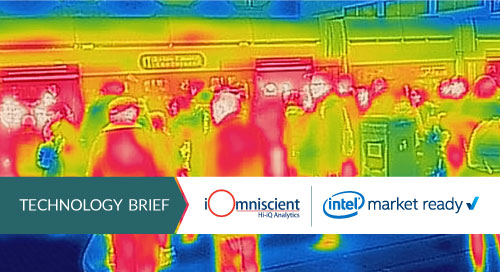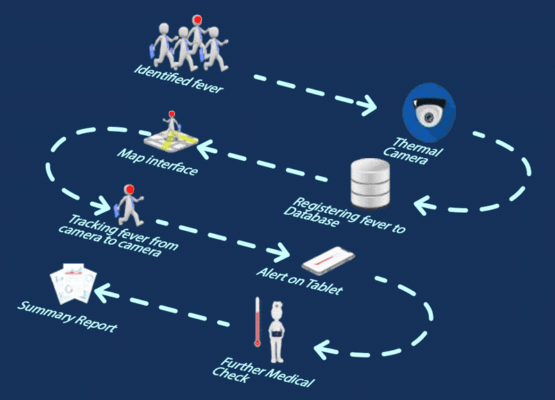AI Fever Detection Checks Crowds, Protects Privacy

Stopping the spread of infectious disease has taken on a new urgency. But what’s the best way to check large groups of people for signs of illness?
One option is to set up a fever screening station. Thermal screening stations are not a new concept. Many of us have walked through them in airports or hospitals.
Up until now, though, thermal screening stations have required one or two people to monitor each station. It is a costly, labor-intensive process that has prevented many public facilities from implementing this powerful public health tool.
iOmniscient, a provider of AI video analytics, sees a better option: Use networked thermal cameras to automate the process. Rather than having individual screening stations—each with its own staff—an entire facility can be monitored from a central location.
“Let’s use an airport as our example,” explains Dr. Rustom A. Kanga, CEO of iOmniscient. The challenge is that if you’ve enabled 100 cameras (one at each gate), you’ll need about 200 people to monitor them. With our automated system, you could just have a small paramedic team in the airport, and they can handle all 100 cameras.” (Video 1)
Making fever detection more widely available can bring a sense of safety and well-being, too. Just think of all the places where people congregate: schools, nursing homes, stadiums, supermarkets, manufacturing plants, restaurants—the list goes on and on.
Automated Fever Detection is Cost-Effective
Automation minimizes operational costs by drastically reducing the number of people required to monitor the system. It can automatically check temperatures cost-effectively (even in a group of people).
Since a person is not required to stand behind each camera, organizations that switch to iQ-FeverCheck typically see a 95 percent reduction in staff required to monitor the system, and a 20X cost savings when compared to other thermal screening systems.
Need a better way to spot fevers? @iOmniscient2 thermal cameras use AI to automate the process. via @insightdottech
This cost savings is even more evident in large locations with multiple entrances like shopping malls and transportation hubs. At these places, it’s common to have multiple thermal cameras in strategic locations. Instead of one or two people working behind each camera, only a couple of paramedics are needed.
Additional benefits built into iQ-FeverCheck:
- Since the system can operate at a long range in a crowd, it eliminates the queue caused by slow, manual fever-screening methods.
- Since the system is automated, it does not add additional strain to already scarce health care resources.
- It can detect an elevated temperature even if someone is wearing a mask.
This thermal camera was designed to not impose on society. For example, instead of positioning the camera on a desk at an entrance (where it can cause anxiety), it can be put in the corner of the room near the ceiling. It is non-intrusive, and it does not interrupt workflows.
What Happens When You See a Fever?
Another benefit of networked cameras: You can catch circumstances where people develop a fever after entering your facility. “You can have cameras all around your facility—in your cafeteria, conference rooms, and so on, wherever people walk. The system constantly screens for fevers, and it will notify the paramedic in your facility if anyone has an elevated temperature,” says Rustom.” In other words, you aren’t just trying to detect fevers in the morning when workers arrive. You can detect them anytime during the day.”
Even better, tracking capability in the iQ-FeverCheck artificial intelligence software tracks the potentially fevered person throughout the facility while the paramedic is notified via the iQ-Mobile app. The paramedic can then identify the fever risk and take appropriate action (Figure 1).

Kanga explains further, “The way it works is that the person could be anywhere. If he has a fever, the camera will notice him and capture his face. Then it will track him. Let’s say he was sitting at his desk, but then he goes to another workstation, and then he wanders into the cafeteria. The system will track him as he goes from one point to the next. It will show the paramedic exactly where he is located on a map on the paramedic’s phone.”
What About Privacy Protection?
Privacy protection is one of the advantages of this system. It maintains the privacy of every person screened by redacting (blurring) their faces. The data is stored with the pixilation intact. iOmniscient’s patented reverse redaction capability is only used when a paramedic needs to identify a feverish person.
This system is fully GDPR compliant. All identities are kept hidden. Only an image (no other data) of the person with an elevated temperature is given to the paramedic.
A Full Suite of Anti-Contagion Capabilities
This thermal screening system comes preloaded with iOmniscient’s proprietary artificial intelligence software designed for fever detection and tracking. Although iQ-FeverCheck operates independently, it is also an integral part of iOmniscient’s broader suite of capabilities called Anti-Contagion.
The systems in the Anti-Contagion suite include:
- iQ-SocialDistance – Monitors social distancing
- iQ-PPE – Monitors personal protective equipment (PPE)
- iQ-Access – Contactless multi-factor access control system
- iQ-Evacuation – Evacuation management system
Like iQ-FeverCheck, these additional systems are automated, thus greatly reducing operational costs.
Final Thoughts
iQ-FeverCheck is a modern solution to the new challenges facing society. It allows essential services to continue operating while managing the health risk to workers at a minimal cost.
iOmniscient’s AI-based solutions are in 60+ countries. The technology in iQ-FeverCheck is based on 70 international patents and two decades of experience. It’s a powerful thermal screening system that can help any organization adapt to the current crisis, and any other viral infections that come our way.